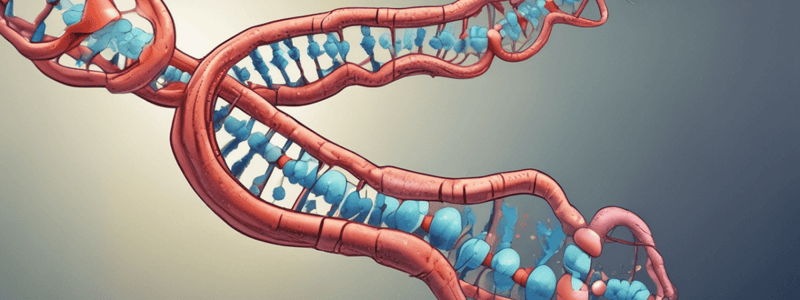Podcast
Questions and Answers
What is the main cause of structural chromosomal abnormalities?
What is the main cause of structural chromosomal abnormalities?
- Maternal age
- Genetic mutations
- Viral infections (correct)
- Ionizing radiation (correct)
What is the result of unbalanced chromosomal rearrangement?
What is the result of unbalanced chromosomal rearrangement?
- No effect on the individual
- Severe clinical effects (correct)
- Only affects the mother
- Harmless effects
What is the characteristic of balanced chromosomal rearrangement?
What is the characteristic of balanced chromosomal rearrangement?
- It results in severe clinical effects
- It is only seen in maternal chromosomes
- It is usually harmless (correct)
- It only affects the father
What is the result of deletion of a short arm of chromosome 5?
What is the result of deletion of a short arm of chromosome 5?
What is the technique used to detect micro-deletion?
What is the technique used to detect micro-deletion?
What is the condition characterized by underdevelopment of the larynx and a characteristic cat-like cry?
What is the condition characterized by underdevelopment of the larynx and a characteristic cat-like cry?
What is the type of inversion that involves both p and q arms?
What is the type of inversion that involves both p and q arms?
What is the indication for routine chromosome investigation?
What is the indication for routine chromosome investigation?
What is the result of terminal deletion of a chromosome?
What is the result of terminal deletion of a chromosome?
What is the type of structural chromosomal abnormality that results in extra copies of a chromosome part?
What is the type of structural chromosomal abnormality that results in extra copies of a chromosome part?
What is the result of a paracentric inversion?
What is the result of a paracentric inversion?
What is the characteristic of a ring chromosome?
What is the characteristic of a ring chromosome?
What is the result of an isochromosome?
What is the result of an isochromosome?
What is the result of an insertion?
What is the result of an insertion?
What is the characteristic of a reciprocal translocation?
What is the characteristic of a reciprocal translocation?
What is the result of a Robertsonian translocation?
What is the result of a Robertsonian translocation?
What is the notation for a normal female karyotype?
What is the notation for a normal female karyotype?
What is the notation for a deletion of a segment on the short arm of chromosome 5?
What is the notation for a deletion of a segment on the short arm of chromosome 5?
What is the characteristic of balanced structural abnormalities?
What is the characteristic of balanced structural abnormalities?
What is the characteristic of unbalanced structural abnormalities?
What is the characteristic of unbalanced structural abnormalities?
Flashcards are hidden until you start studying
Study Notes
Chromosomal Abnormalities
- Chromosomal abnormalities result from breakage and incorrect rejoining of chromosomal segments, leading to disease.
- Environmental factors responsible for structural abnormalities include: • Ionizing radiation • Ultraviolet light • Chemical agents • Viral infections
Indications for Chromosome Investigation
- Prenatal screening: • Down's syndrome, especially in cases of advanced maternal age (>35 years) or family history of chromosome abnormality • Abnormal ultrasound scan of fetus
- Birth defects: • Malformations • Mental retardation
- Abnormal sexual development (e.g., Klinefelter's syndrome)
- Infertility
- Recurrent fetal loss
Types of Structural Chromosomal Abnormalities
- Balanced rearrangements: • Exchange or rearrangement of genetic material without loss or gain of genetic material • Generally harmless, but carriers are at risk of producing children with unbalanced chromosomal complement
- Unbalanced rearrangements: • Incorrect amount of chromosomal material, resulting in severe clinical effects
Deletions
- Loss of genetic material, resulting in monosomy for the segment of the chromosome
- Types of deletions: • Terminal deletion: involves a single break of the terminal part of the chromosome • Interstitial deletion: involves two breaks and loss of the intervening portion of the chromosome
- Example: Cri-du-Chat syndrome (46,XX,5p- or 46,XY,5p-)
Duplications
- Extra copies of a chromosome part
Inversions
- Involves two breaks along the chromosome, resulting in a reversal of a segment
- Types of inversions: • Pericentric inversion: involves both p and q arms with centromere • Paracentric inversion: involves only one arm
Ring Chromosomes
- Loss of telomeres or ends of both arms of a chromosome, forming a ring structure
Isochromosomes
- Creation of two non-identical chromosomes, one with a combination of short arms, the other with a combination of long arms
Insertions
- Rearrangement of genetic material to a non-homologous chromosome, without loss of genetic material
Translocations
- Exchange of genetic material between two chromosomes
- Types of translocations: • Reciprocal translocation: no loss of genetic material, but an exchange of genetic material between two non-homologous chromosomes • Robertsonian translocation (centric fusion): involves break at or near the centromere in two acrocentric chromosomes and subsequent fusion of their long arms
Karyotype Nomenclature
- Normal female or male: 46,XX or 46,XY
- Extra or missing entire chromosome: e.g., 47,XX,+21 or 45,XX,-15
- Missing piece of a chromosome: e.g., 5p-
- Other notations include: • del (deletion) • dup (duplication) • inv (inversion) • ins (insertion) • rob (Robertsonian translocation) • t (translocation)
Studying That Suits You
Use AI to generate personalized quizzes and flashcards to suit your learning preferences.
